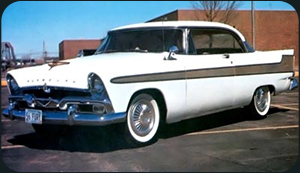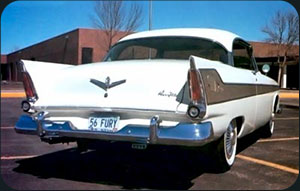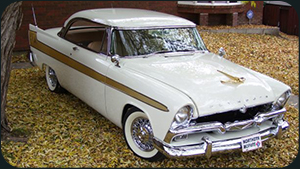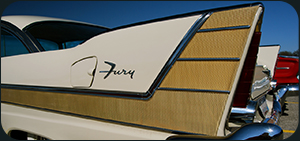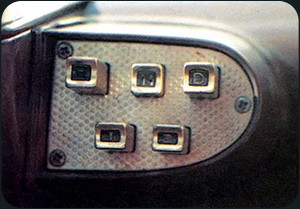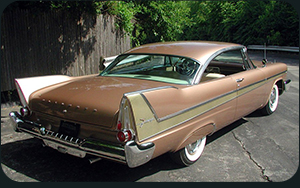1956-58 Plymouth Fury
The 1958 Plymouth Fury from Chrysler Corp. is best known as the
diabolical car in the Stephen King novel "Christine" and subsequent
1983 horror movie of the same name.
The 1958 Fury was the last and most powerful of the classic 1956-58
Fury models, although the 1956 Fury was the first to blow things wide
open for Plymouth, which long was known for making reliable, slow, boxy
cars.
Still, Plymouth was a thriving Chrysler division favored mainly by
older folks, especially in farming communities. The first Plymouth
arrived as a low-cost car in heavily agricultural America in 1928. The
Plymouth name, of course, referred to Plymouth Rock, Massachusetts, but
founder Walter Chrysler wasn't sure if people would make the connection
until an ex-farm boy Chrysler executive said, "Every damn farmer in
America's heard of ol' Plymouth Binder Twine"--a well-known farm
product.
The 1955 Plymouth models finally got sharp styling, with available
two-tone paint. And the car was offered with its first V-8--a
260-cubic-inch engine that produced up to 177 horsepower with a
four-barrel carburetor and dual exhausts. Prevous Plymouths had tame
six-cylinder engines with approximately 100 horsepower. The 1955
Plymouth's styling and V-8 helped make it a complete departure from
past Plymouths. You could even get it for the first time with optional
air conditioning, power windows and power front
seats.
Plymouths were given even sharper styling for 1956, and the limited
production Fury arrived that year as a hot rod version with 240
horsepower--a lot then for a mid-sized car.
The 1956 Fury really stood out. It had the same slick hardtop coupe
body of the high-line Plymouth Belvedere and featured striking custom
eggshell white paint set off on each body side by a full-length
sweepspear of gold anodized aluminum that resembled a lightning bolt.
Anodized gold also decorated the grille center and unique "spoke" wheel
covers.
The Fury's special interior had colors that matched the vivid exterior.
Most sports cars had tachometers, but the Fury was among few American
cars with that gauge.
A pre-production Fury shot through the Flying Mile at Daytona Beach,
Fla., at 124 mph-- on the same day the car was introduced at the 1956
Chicago Auto Show. The following month, a Fury with twin four-barrel
carburetors hit 143.6 mph at Daytona.
Veteran Plymouth owners--a conservative lot--could hardly believe it.
Plymouth declined using Chrysler's potent "Hemi" V-8 for the Fury.
Instead, it chose a 303-cubic-inch "polyhead" V-8 from a Canadian
Chrysler, partly because that V-8 qualified for a NASCAR racing class.
Plymouth added a high-performance camshaft, solid valve lifters, domed
pistons, a four-barrel carburetor, free-flow dual exhausts and higher
compression heads. The top engine for other Plymouths was an optional
277-cubic-inch V-8 with 200 horsepower.
The Fury contributed to Plymouth's growing high-performance image, and
4,485 were sold. That was pretty good for a specialized model priced at
$2,866, or some $652 higher than the Belvedere Sport Coupe hardtop. The
1956-58 Fury was always the most expensive Plymouth.
All 1956-58 Fury coupes--and even the less-exclusive 1959 Sport
Fury--had powerful V-8s and cosmetic gold features.
The 1956 Fury featured a special sport suspension that gave it a
low-slung look, along with huge brakes, special tires and a front
anti-sway bar. Power flowed through a standard heavy duty three-speed
manual transmission or optional two-speed "PowerFlite" automatic with
pushbutton controls on the dashboard.
The 1957 Fury coupe looked even sleeker because all Chrysler Corp. cars
for that year were totally restyled to become the industry's
best-looking autos, stealing the styling crown from General Motors. The
1957 Plymouth was so new and striking that its advertisements
proclaimed, "Suddenly it's 1960!"
GM stylists got a sneak look at the 1957 Chrysler Corp. autos and
hastily retreated to their drawing boards to restyle future GM cars.
The new Plymouth had a daring low window line, lots of glass area,
heavily browed headlights and prominent, but nicely integrated,
tailfins. Its wheelbase was 3 inches longer, and it was an astonishing
5.5 inches lower than the 1956 model. The coupe had an exquisitely
shaped thin-section roof that seemingly "floated" above the car.
The 1957 Fury again arrived after the rest of the hot-selling Plymouth
line. It had the same white and gold side trim as the 1956 model. The
anodized gold wheel covers were gone, but gold grille bars were added.
The interior had a two-tone steering wheel, a "sweep-second
self-regulating watch," padded dashboard and dealer-installed seat
belts, which were rare in 1957.
Power now came from a larger 318-cubic-inch V-8. It produced 290
horsepower with dual four-barrel carburetors, special camshaft,
high-compression engine heads, heavy duty valve springs and
free-flowing dual exhausts.
A three-speed manual transmission again was standard, but Fury buyers
now could get Chrysler's new three-speed "TorqueFlite" automatic
transmission with pushbutton controls. It was the industry's best
automatic for years.
Chrysler's new torsion-bar front suspension helped make the 1957 Fury
one of the best-handling cars, even topping some sports cars in
roadability.
A total of 7,438 Furys were produced for 1957, when the car cost
$2,925..
Chrysler spent big money in the 1950s--some $300 million--restyling its
1957 models. The 1958 Fury thus looked much the same as its
predecessor. It retained the Fury's distinctive color scheme and gold
anodized grille, but got four headlights, "lollipop" taillights and
wheel covers with gold centers. It was priced at $3,067.
The 290-horsepower V-8 was standard, but you could order a "Golden
Commando" 350-cubic-inch V-8 that broke the 300-horsepower barrier with
305 horsepower. With optional, then-exotic fuel injection, that engine
kicked out 315 horsepower.
A bad recession that affected all automakers held down production of
the 1958 Fury to 5,308 cars. But the 1956-58 Fury was such a success in
creating a sporty image for Plymouth that it put the Fury name on its
top-line standard-series 1959 coupe and sedan models.
That move eliminated the special appeal of the first three Fury models.
But a high-performance Sport Fury model served as the replacement for
the 1956-58 Fury. Production of the $2,927 Sport Fury coupe, which
resembled the 1956-58 coupes, totaled 17,867 units.A $3,125 Sport Fury
convertible that was added found 5,990 buyers. The Sport Fury had a
standard 260-horsepower V-8, but a 305-horsepower V-8 was optional.
Decades later, author Stephen King selected the 1958 Fury to star
in "Christine," and that says a lot about what a sexy car it
was--and still is.
